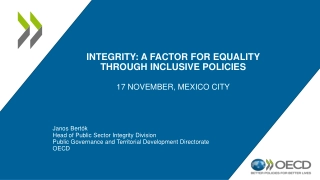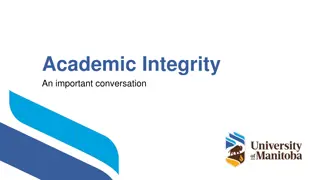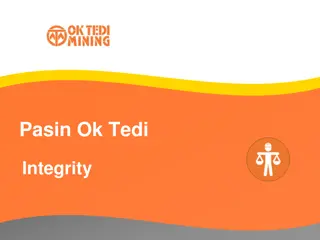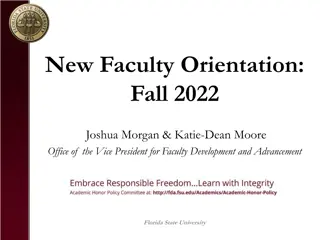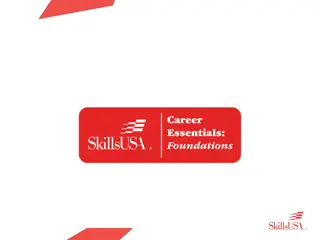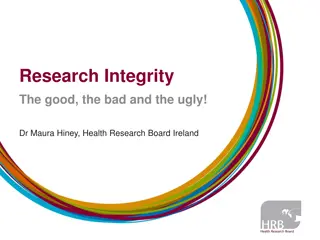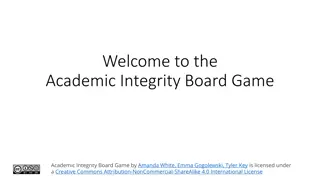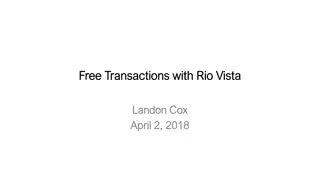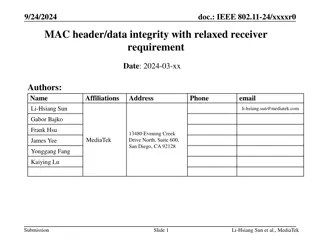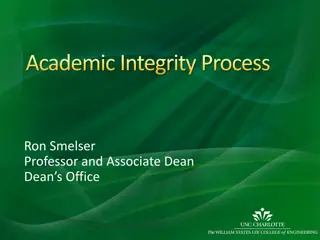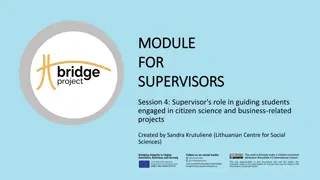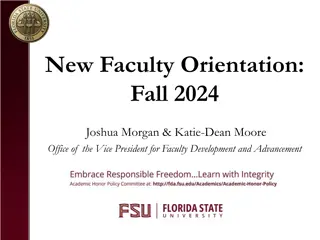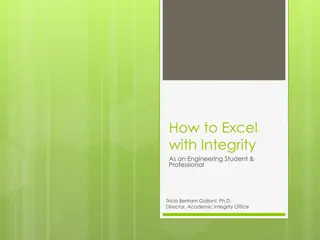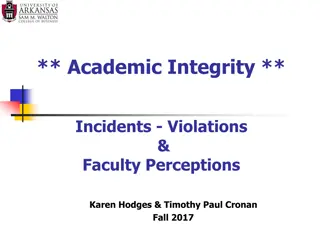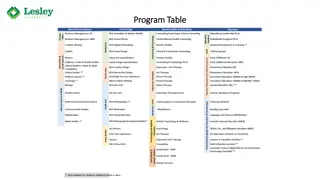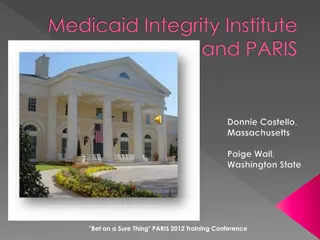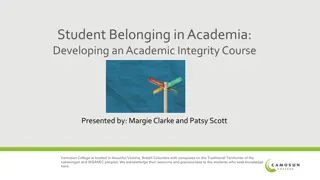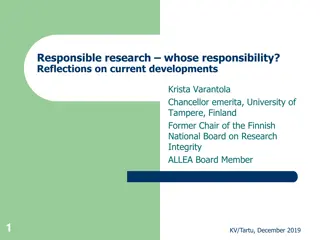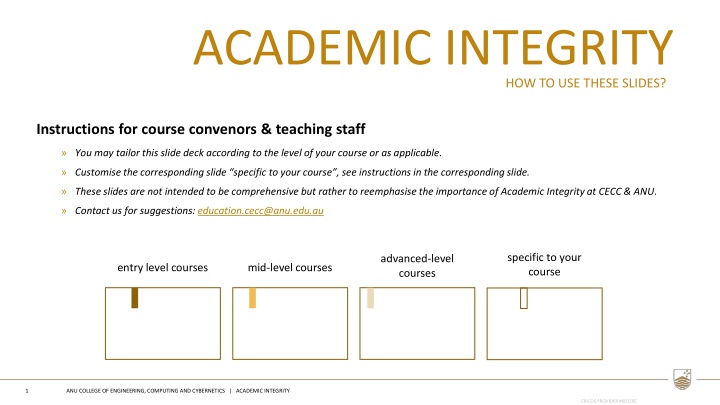
Academic Integrity Guidelines for CECC Course Convenors and Teaching Staff
This slide deck provides instructions for course convenors and teaching staff on how to use and customize slides related to academic integrity. It emphasizes the importance of upholding academic integrity principles at ANU and offers guidance on reporting breaches and fostering a culture of integrity.
Download Presentation

Please find below an Image/Link to download the presentation.
The content on the website is provided AS IS for your information and personal use only. It may not be sold, licensed, or shared on other websites without obtaining consent from the author. If you encounter any issues during the download, it is possible that the publisher has removed the file from their server.
You are allowed to download the files provided on this website for personal or commercial use, subject to the condition that they are used lawfully. All files are the property of their respective owners.
The content on the website is provided AS IS for your information and personal use only. It may not be sold, licensed, or shared on other websites without obtaining consent from the author.
E N D
Presentation Transcript
ACADEMIC INTEGRITY HOW TO USE THESE SLIDES? Instructions for course convenors & teaching staff You may tailor this slide deck according to the level of your course or as applicable. Customise the corresponding slide specific to your course , see instructions in the corresponding slide. These slides are not intended to be comprehensive but rather to reemphasise the importance of Academic Integrity at CECC & ANU. Contact us for suggestions: education.cecc@anu.edu.au specific to your course advanced-level courses entry level courses mid-level courses 1 ANU COLLEGE OF ENGINEERING, COMPUTING AND CYBERNETICS | ACADEMIC INTEGRITY CRICOS PROVIDER #00120C
ACADEMIC INTEGRITY GENERAL INFORMATION Academic Integrity is taken seriously at ANU! The Academic Integrity Rule 2021 (Rule) is a legal document that the University uses to promote academic integrity, and manage breaches of the academic integrity principle. Click here to learn more about the academic integrity rules. All students are expected, both individually and collectively and to the best of their ability, to advance the pursuit, dissemination and application of knowledge ethically, and by behaving honestly and responsibly, and with respect and fairness, in scholarly practice. The academic integrity principle is the principle that every student of the University: is committed to engaging in academic work in ways that are consistent with, and actively support, academic integrity; and (a) upholds this commitment by behaving honestly, responsibly and ethically, and with respect and fairness, in scholarly practice. (b) 2 ANU COLLEGE OF ENGINEERING, COMPUTING AND CYBERNETICS | ACADEMIC INTEGRITY CRICOS PROVIDER #00120C
ACADEMIC INTEGRITY GENERAL INFORMATION We are all responsible for maintaining a culture of Academic Integrity at ANU. We have an obligation to be informed of and to understand the requirements of academic integrity and the academic integrity principle. Being uninformed of or misunderstanding the requirements of academic integrity will never be an excuse for a breach of academic integrity. How do I know about the Academic Integrity Rules? As a student, you are expected to undertake the online Academic Integrity modules on Wattle before submitting your first piece of assessment. These modules will guide you to a successful academic journey with integrity. A culture of Academic Integrity starts with you. How to report and foster academic integrity? We cannot ignore situations in which we have any evidence that someone has breached academic integrity, and must deal with the situation in an appropriate way as stated in the Student Code of Conduct (item 11, reporting). Contact your course convenor, the teaching staff or the Sub Dean (Academic Integrity). If you need further assistance, please contact education.cecc@anu.edu.au. Your identity will be kept confidential. 3 ANU COLLEGE OF ENGINEERING, COMPUTING AND CYBERNETICS | ACADEMIC INTEGRITY CRICOS PROVIDER #00120C
courses with coding ACADEMIC INTEGRITY while (integrity) knowledge++; How do I acknowledge other people's work in my code? Include in comments next to the code you reuse, the URL, author and date you extracted the code, and a brief explanation of whether you adapted the code or used it as-is (see real-world examples below). Example 1 In describing the class PluginProxyUtil in the Apache Project source code, the developer cites the source as a post in a forum and includes the URL, author and date. Don't forget to indicate whether or not you modified the code (be clear and explain the changes in the comments). /** * A utility class that gives applets the ability to detect proxy host settings. * This was adapted from a post from Chris Forster on 20030227 to a Sun Java forum here: * http://forum.java.sun.com/thread.jspa?threadID=364342&tstart=120 [...] */ Example 2 In the function OutputTraceToStreamin the Google Chrome stack_trace_win source code, the developer cites the source code as the Microsoft Developer Network and includes a URL: // Code adapted from MSDN example: // http://msdn.microsoft.com/en-us/library/ms680578(VS.85).aspx Note that when you use code from an open-source project, you need both to attribute the source and follow the terms of any open-source license that applies to the code you are using. Source: Academic Integrity at MIT/Writing code https://integrity.mit.edu/handbook/writing-code retrieved in February 2023. 4 ANU COLLEGE OF ENGINEERING, COMPUTING AND CYBERNETICS | ACADEMIC INTEGRITY CRICOS PROVIDER #00120C
ACADEMIC INTEGRITY while (integrity) knowledge++; Plagiarism is the appropriation of the ideas or expressions of another without relevant and appropriate acknowledgment. It is considered plagiarism if you have copied someone else s work, including another student s paper, recycled some of your own work, or taken material directly from another source and made it appear to be your own. Your ideas, your argument and your analysis are the most important aspects of your work. Examples I used several sources to solve this assignment. There's a mix of my ideas and parts of others. I thought it was considered mine. [Plagiarism] The code I used in my assignment was pulled from StackOverflow but I didn t realise I had to reference an online post. [Plagiarism] I failed this course before. So I reused my own assignments as I thought I could reuse them. [Self-Plagiarism] *Note that the examples are not intended to be comprehensive but rather illustrative of common breaches of academic integrity. 5 ANU COLLEGE OF ENGINEERING, COMPUTING AND CYBERNETICS | ACADEMIC INTEGRITY CRICOS PROVIDER #00120C
ACADEMIC INTEGRITY while (integrity) knowledge++; Collusion and Collaboration are not the same thing. Never misrepresent someone else s knowledge, ideas, or outputs as your own. The nature and extent of interaction (collaboration) must be formally acknowledged such that the specific contribution of the author (or authors for a group project) can be unambiguously distinguished from the contribution of non-authors. Unacknowledged collaboration may be collusion, which is a breach of the Academic Integrity Principle. Examples I discussed the group assignment with my teammates and acknowledged each one's contribution to the assignment. [Collaboration] I discussed the assignment with a friend, but I forgot to acknowledge their contribution to my assignment. [Collusion] I discussed the individual assignment with a friend and acknowledged their contribution to my assignment. [Collusion] *Note that the examples are not intended to be comprehensive but rather illustrative of common breaches of academic integrity. 6 ANU COLLEGE OF ENGINEERING, COMPUTING AND CYBERNETICS | ACADEMIC INTEGRITY CRICOS PROVIDER #00120C
ACADEMIC INTEGRITY while (integrity) knowledge++; Contract Cheating Contract Cheating is submission of an academic output that is prepared or drafted in part or in full by a person who is not acknowledged in the output as an author or co-author of the output; both the person writing the output and the person submitting the output are guilty of Contract Cheating. Contract cheating is so serious that it may result in criminal prosecution under Australian Commonwealth Government legislation. No matter how much pressure you are under, engaging in this is far worse than failure to submit an assignment. Examples I used a social network to find someone and paid them to the assignment for me [Contract Cheating] I used a solution taught by an online tutoring company. I thought it was ok. [Contract Cheating] I bought notes and tutorial answers from a friend who has taken this course before. [Contract Cheating] *Note that the examples are not intended to be comprehensive but rather illustrative of common breaches of academic integrity. 7 ANU COLLEGE OF ENGINEERING, COMPUTING AND CYBERNETICS | ACADEMIC INTEGRITY CRICOS PROVIDER #00120C
ACADEMIC INTEGRITY while (integrity) knowledge++; Other common cases of breaches Examples During my research project, I received advice from experts/workshop staff about a design decision, but I forgot to acknowledge them. [Collusion, Plagiarism] I cited and referred to that source once in my research report, and it felt repetitive and unnecessary to refer to it each time. I expected the reader to know where those ideas come from. [Plagiarism] I reused pieces of my previous assignments in my final research project. I did not know I had to acknowledge my own work. [Improperly Recycling Work] The results of my research project were no better than state of the art, so I made up data and reported better results. [Falsification/Data Fabrication] Partial or total recycling of previous work is only allowed when expressly approved in the Class Summary and/or Wattle. Scaffolding assessments are an example where reuse is permitted. Do not forget to cite your previous work (as unpublished if not previously published), following the referencing style adopted in your report. *Note that the examples are not intended to be comprehensive but rather illustrative of common breaches of academic integrity. 8 ANU COLLEGE OF ENGINEERING, COMPUTING AND CYBERNETICS | ACADEMIC INTEGRITY CRICOS PROVIDER #00120C
ACADEMIC INTEGRITY while (integrity) knowledge++; The Use of Generative AI Tools Generative AI tools (e.g. ChatGPT, Co-Pilot) are computer programs that use machine learning algorithms to generate new and original data or content. They can be used to generate text, images, music, or videos that are not explicitly programmed but are learned from a large dataset of examples. OpenAI. (2023, February 16). What are Generative AI tools? [Response to a question]. Retrieved from https://github.com/openai/gpt Can I use Generative AI Tools?* > Use of generative AI tools is allowed unless expressly prohibited in the Class Summary/Wattle and Assignment Sheet. > You must acknowledge, provide the prompt(s) and cite the use of any Generative AI tools in your work. > Uncited use of generative AI tools is considered a potential breach of the Academic Integrity Rules. *Note that this is an evolving space and recommendations and rules related to the use of generative AI tools are subject to change. Always ask teaching staff if you are not sure whether the use of these generative AI tools is allowed. Examples I acknowledged and cited all parts of the assignment where I used generative AI tools, including my prompts. The assignment sheet did not mention it was not allowed. [OK] I used a generative AI tool and acknowledged it in my report. The assignment sheet mentioned that it was not allowed, but I missed that part. [NOT OK] I did not properly cite the parts of my work where I used Generative AI tools. [NOT OK] *Note that the examples are not intended to be comprehensive but rather illustrative of common breaches of academic integrity. 9 ANU COLLEGE OF ENGINEERING, COMPUTING AND CYBERNETICS | ACADEMIC INTEGRITY CRICOS PROVIDER #00120C
ACADEMIC INTEGRITY while (integrity) knowledge++; /** TODO INCLUDE TYPICAL EXAMPLES OF BREACHES IN THE ACADEMIC INTEGRITY RULES IN YOUR COURSE HERE The Academic Integrity Rules 2021 are always the same. However, for pedagogical reasons, what is acceptable in one course may not be acceptable in another. Clarify your expectations in this slide. */ Typical Examples in COMPXXXX. Example 1 Assignment X Example 2 Breach of Self-Invigilation rules Example 3 Using Online Resources (Chegg, StackOverflow, Reddit, tutorialspoint.com, geeksforgeeks.org) Example 4 Using Generative AI tools [Co-Pilot, ChatGPT] 10 COLLEGE OF ENGINEERING, COMPUTING AND CYBERNETICS | ACADEMIC INTEGRITY CRICOS PROVIDER #00120C
ACADEMIC INTEGRITY while (integrity) knowledge++; We understand almost all people who breach academic integrity don t want to, but do so because they feel under pressure (such as running out of time, lack of confidence, not knowing where to start) and see cheating or otherwise breaching academic integrity as their only way out. It isn t. It never is! We can help you! How to get help? Contact your course convenor or course teaching staff if you have any questions about your assignments and academic integrity. They are there to support you. Visit the ANU Academic Skills Web page and book an appointment to discuss academic integrity, referencing, time management, best practice principles, among others. They will offer the right guidance. Get support from the Access & Inclusion staff to ensure you have all the conditions to perform at your best (eligibility applies). They can arrange extra support for you. Get help from ANU Counselling staff, the Dean of Students, the Associate and Sub-Dean (Academic Integrity), Student Association and other relevant staff. We are all here for academic integrity! 11 ANU COLLEGE OF ENGINEERING, COMPUTING AND CYBERNETICS | ACADEMIC INTEGRITY CRICOS PROVIDER #00120C
ACADEMIC INTEGRITY while (integrity) knowledge++; In summary: Academic dishonesty is a serious matter and is not tolerated. Severe penalties may apply for violations of academic integrity rules. Always acknowledge others work. Don't hesitate to ask for help! Report any academic dishonesty, we are all responsible for academic integrity. Academic dishonesty will affect your learning, confidence, development of new skills, future career, and personal and institutional reputation. References Academic Integrity Rules (2021) https://www.legislation.gov.au/Details/F2021L00997 Academic Integrity: Best Practice Principles for Learners https://services.anu.edu.au/learning-teaching/academic-integrity/academic-integrity-best-practice-principles-for-learners More info at https://cecc.anu.edu.au/current-students/program-management/academic-integrity-and-misconduct 12 ANU COLLEGE OF ENGINEERING, COMPUTING AND CYBERNETICS | ACADEMIC INTEGRITY CRICOS PROVIDER #00120C

